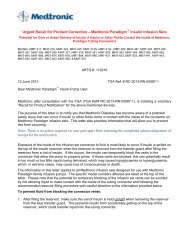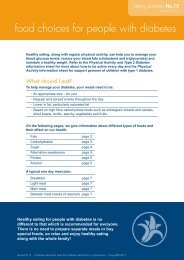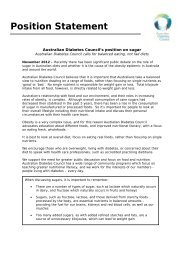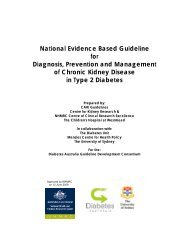Part 6: Detection and Prevention of Foot Problems in Type 2 Diabetes
Part 6: Detection and Prevention of Foot Problems in Type 2 Diabetes
Part 6: Detection and Prevention of Foot Problems in Type 2 Diabetes
You also want an ePaper? Increase the reach of your titles
YUMPU automatically turns print PDFs into web optimized ePapers that Google loves.
<strong>and</strong> orthopaedic surgeons (Thomson et al, 1991). In the Italian study the team<strong>in</strong>cluded a diabetologist, nurse specialist, orthopaedic surgeon, podiatrist, vascularsurgeon <strong>and</strong> radiologist (Ghirl<strong>and</strong>a et al, 1997). In the Swedish study the teamcomprised a diabetologist, orthopaedic surgeon, diabetes nurse, podiatrist <strong>and</strong>orthotist (Larsson et al, 1995). In the London specialised foot cl<strong>in</strong>ic the team <strong>in</strong>cludeda podiatrist, shoe-fitter, nurse, physician <strong>and</strong> surgeon (Edmonds et al, 1986). In theprospective Lithuanian study the team <strong>in</strong>cluded a diabetologist, rehabilitationphysician, podiatrist, orthopaedic surgeon <strong>and</strong> shoe makers (Dargis et al, 1999).In summary, the common components <strong>of</strong> the specialist multi-discipl<strong>in</strong>ary team havebeen a physician <strong>and</strong> podiatrist. Most have also <strong>in</strong>cluded a specialist nurse <strong>and</strong>orthotist <strong>and</strong> all have <strong>in</strong>volved or had ready access to a surgeon.The podiatrist is an essential member <strong>of</strong> the multi-discipl<strong>in</strong>ary team. Plank et al(2003) evaluated the impact <strong>of</strong> regular podiatric care on the recurrence rate <strong>of</strong> diabeticfoot ulcers among 91 people (mean age 65 years) with diabetes <strong>and</strong> healed foot ulcers.47 people were r<strong>and</strong>omly assigned to the <strong>in</strong>tervention group <strong>in</strong> which people receivedmonthly chiropodist care, while 44 were assigned to the control group <strong>in</strong> whichpodiatric care was not recommended. Dur<strong>in</strong>g the median follow-up <strong>of</strong> 386 days, 18people <strong>in</strong> the <strong>in</strong>tervention group suffered from ulceration compared with 25 people <strong>in</strong>the control group (HR 0.60, CI 0.32-1.09; p=0.09). However, there were fewer feetaffected <strong>in</strong> the <strong>in</strong>tervention group than <strong>in</strong> the control group (20 feet v 32 feet, RR0.52, CI 0.29-0.93; p=0.03). There was no significant difference <strong>in</strong> the location <strong>of</strong>ulcers between the two groups. M<strong>in</strong>or amputation was performed <strong>in</strong> two people <strong>in</strong> the<strong>in</strong>tervention group <strong>and</strong> one person <strong>in</strong> the control group. At the end <strong>of</strong> follow-up, therewas a significant reduction <strong>in</strong> overall events <strong>of</strong> ulceration, amputation <strong>and</strong> death <strong>in</strong> thepodiatric care group (18 v 29 events, HR 0.54, CI 0.30-0.96; p=0.03).Further research is required to def<strong>in</strong>e the core services <strong>in</strong> multi-discipl<strong>in</strong>ary carewhich are essential <strong>in</strong> improv<strong>in</strong>g outcomes by reduc<strong>in</strong>g the <strong>in</strong>cidence <strong>of</strong> ulcer oramputation <strong>in</strong> people with diabetes with high risk feet (P<strong>in</strong>zur et al, 1996).87
















